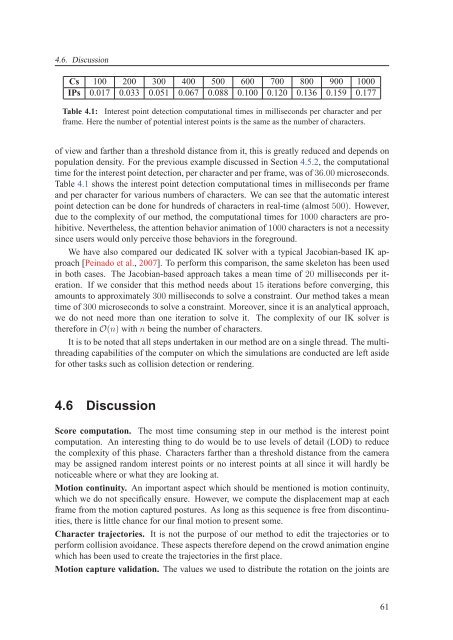Texte intégral / Full text (pdf, 20 MiB) - Infoscience - EPFL
Texte intégral / Full text (pdf, 20 MiB) - Infoscience - EPFL
Texte intégral / Full text (pdf, 20 MiB) - Infoscience - EPFL
You also want an ePaper? Increase the reach of your titles
YUMPU automatically turns print PDFs into web optimized ePapers that Google loves.
4.6. Discussion<br />
Cs 100 <strong>20</strong>0 300 400 500 600 700 800 900 1000<br />
IPs 0.017 0.033 0.051 0.067 0.088 0.100 0.1<strong>20</strong> 0.136 0.159 0.177<br />
Table 4.1: Interest point detection computational times in milliseconds per character and per<br />
frame. Here the number of potential interest points is the same as the number of characters.<br />
of view and farther than a threshold distance from it, this is greatly reduced and depends on<br />
population density. For the previous example discussed in Section 4.5.2, the computational<br />
time for the interest point detection, per character and per frame, was of 36.00 microseconds.<br />
Table 4.1 shows the interest point detection computational times in milliseconds per frame<br />
and per character for various numbers of characters. We can see that the automatic interest<br />
point detection can be done for hundreds of characters in real-time (almost 500). However,<br />
due to the complexity of our method, the computational times for 1000 characters are prohibitive.<br />
Nevertheless, the attention behavior animation of 1000 characters is not a necessity<br />
since users would only perceive those behaviors in the foreground.<br />
We have also compared our dedicated IK solver with a typical Jacobian-based IK approach<br />
[Peinado et al., <strong>20</strong>07]. To perform this comparison, the same skeleton has been used<br />
in both cases. The Jacobian-based approach takes a mean time of <strong>20</strong> milliseconds per iteration.<br />
If we consider that this method needs about 15 iterations before converging, this<br />
amounts to approximately 300 milliseconds to solve a constraint. Our method takes a mean<br />
time of 300 microseconds to solve a constraint. Moreover, since it is an analytical approach,<br />
we do not need more than one iteration to solve it. The complexity of our IK solver is<br />
therefore in O(n) with n being the number of characters.<br />
It is to be noted that all steps undertaken in our method are on a single thread. The multithreading<br />
capabilities of the computer on which the simulations are conducted are left aside<br />
for other tasks such as collision detection or rendering.<br />
4.6 Discussion<br />
Score computation. The most time consuming step in our method is the interest point<br />
computation. An interesting thing to do would be to use levels of detail (LOD) to reduce<br />
the complexity of this phase. Characters farther than a threshold distance from the camera<br />
may be assigned random interest points or no interest points at all since it will hardly be<br />
noticeable where or what they are looking at.<br />
Motion continuity. An important aspect which should be mentioned is motion continuity,<br />
which we do not specifically ensure. However, we compute the displacement map at each<br />
frame from the motion captured postures. As long as this sequence is free from discontinuities,<br />
there is little chance for our final motion to present some.<br />
Character trajectories. It is not the purpose of our method to edit the trajectories or to<br />
perform collision avoidance. These aspects therefore depend on the crowd animation engine<br />
which has been used to create the trajectories in the first place.<br />
Motion capture validation. The values we used to distribute the rotation on the joints are<br />
61

















